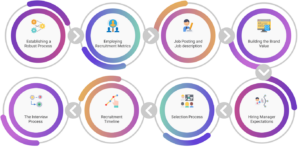Importance of right talent in the success of any organization cannot be emphasized enough. The human resources hired by an organization are their biggest cost and at the same time their biggest investment for return. A resource who may not be a great fit for employer A may be the best fit for employer B. By fitment, I don’t mean how the employee is well suited in terms of experience and qualifications for a given role, but also how the said role will be a great fit for the employee in his career growth and meet his goals and aspirations. Hence, it would be wise to say that recruitment is a two-way process with duplex communication and expectation meeting at both ends.
Most start-ups work based on the current requirement and gut-instinct for hiring resources. However, choosing and hiring a resource must align with the long-term corporate strategy and should be aimed at recruiting the best-fit resources who are willing to stay long-term as they see the company vision and strategy aligning with their personal career goals too. There is no one tailor-made one-size-fits-all solution or process for effective recruitment policy. Thus, evolving best practices over time makes a huge difference to successful hiring and retention of employees in organizations of all sizes. Added to this the fact that effective hiring practices not only ensure employee longevity and loyalty but also help establish a brand image of the organization.

Enumerated and elaborated below are some of the best hiring practices recommended by the hiring veterans and experts.
Establishing a robust process
Recruitment process is a vital business process like all others and has to be well-planned and implemented. It needs to be adapted and evolved based on the changing dynamic needs of an organization passing through different growth phases. Hence, the recruitment plan needs to be made flexible yet fixed to accommodate the changing needs.

Employing recruitment Metrics
Although it is difficult to quantify the recruitment metrics due to the massive involvement of human factor, yet some recruiting metrics such as measurements of sourcing, quality or hire, and satisfaction rating can unveil that data you need to make necessary changes. These metrics usually include candidate sources, how candidates are applying for jobs, and the skill sets of candidates. Recruiting metrics enable a comparison on data from the recruiting process and strategies to the corporate strategy.

Job Posting and Job description
With the numerous similar looking jobs in the market, the prospect employee is usually looking for a one that stands out in the pool. Instead of writing monotonous, lengthy routine job descriptions, the recruitment team needs to focus on making them catchier with a hook phrase as an example. Nowadays, some innovative techniques such as video descriptions are also being added to better explain the role and requirements to the prospective applicant. Adding a touch of humorous satire can also help make the posting stand out from the rest. Key is to make the job posting as unique as possible, marketing your brand in the most unique way as possible.

Building the Brand Value
Building a brand value so that the prospective applicant gets an idea about the company can work wonders to the hiring process. A video message from some key members of the leadership can give a fair idea to the applicant about the vision, mission and goals of the company as a whole. Talking about the customer base and expansion plans can also be a good idea. This can serve as a major information base to the prospective employees and can help make them see if they fit in the company environment and also if they see themselves sticking to the role for a long term.

Hiring Manager Expectations
While most of the times the recruitment team understands the role and job description from the hiring team about the requirements and skill sets for a current position, it is a great idea to have the hiring manager explain the role. As mentioned before, video job descriptions can be an amazing idea wherein the hiring manager explains the role and skills expected, the team constitution and the reporting structure. Coming directly from the horse’s mouth, this can give confidence to the applicant about his fitment and success rate in the said role.

Selection Process
Innovative processes can be adopted to assess the candidate before calling them for an in-person interview and also to shortlist the candidates if the resource pool is too large. Small projects/situations maybe presented to candidates in order to assess them before considering about hiring them. A time frame may be provided and based on the response they produce and present, a suitable decision may be taken whether to move forward with them. This can serve as a very effective comparative tool to rate the candidates also.

Recruitment Timeline
It is important that the recruitment process is designed and executed in such a way that the ‘time-to-recruit’ from receiving the application to presenting the offer is not a very lengthy and time-consuming process. If the time-to-recruit is very long, then the candidate tends to lose interest and may decide to explore and move over to other opportunities. Not only that, a longer recruitment cycle also comes at an enormous cost. However, a relatively shorter and hastened recruitment cycle can lead to wrong hires which again can cost the company in terms of money, time and effort. Hence it’s important to strike the right balance and have an optimum ‘time-to-recruit’, which doesn’t impinge on the integrity of the company and also results in hiring the right candidate who is the best fit for the role.

The Interview Process
Interviews tend to make people nervous and jittery, especially if they are conducted in the boring traditional ways. The nervousness and formality associated with the process may inhibit the candidate from putting his best foot forward and may not be able to show his talent and abilities to their full potential. Instead, it maybe tried to acclimatize the candidate by trying informal interview ideas such as setting up interviews at fun places like cafeterias instead of gloomy office environment. Once the candidate is at ease, more rounds, which may be formal, can be arranged. A tour of the facility prior to the formal interview with the hiring manager/team or SMEs can be conducted where apart from the HR department, the other company personnel can also be involved.

Implementing these recruiting practices can make a powerful difference in the effectiveness and success of recruiting programs by streamlining them. These practices and the recruitment process in general, can be tailored based on the structure, nature of business and needs of the organization to ensure that the recruiting function becomes a smooth and efficient process.




